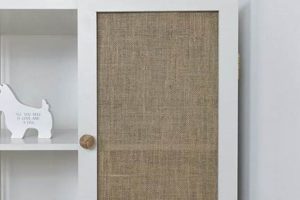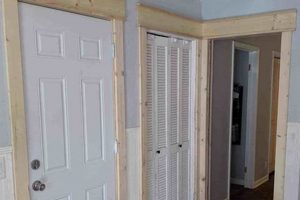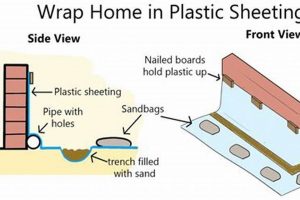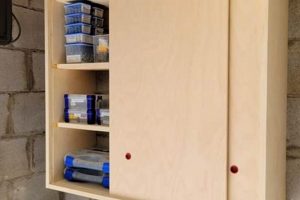A self-assembled screen door constitutes a barrier, typically constructed from a lightweight frame and mesh material, designed to allow ventilation while preventing the entry of insects. These structures are commonly affixed to exterior doorways of residential buildings, providing an alternative to closed doors during periods of favorable weather. Construction materials often include wood, aluminum, or vinyl, with fiberglass or metal screening acting as the barrier. An example application involves a homeowner constructing and installing this type of door to improve airflow and reduce insect presence within their home.
The construction and installation of these doors offer several benefits. Individuals may achieve cost savings compared to professional installation services. The process facilitates customization, enabling the creation of doors sized and styled to specific requirements and aesthetic preferences. Historically, the practice reflects a tradition of self-reliance and resourcefulness, allowing individuals to address practical needs within their living spaces. This approach fosters a sense of accomplishment and control over one’s immediate environment.
Subsequent sections will address critical considerations for successful self-assembly, including material selection, precise measurement techniques, frame construction methods, screen attachment protocols, and installation procedures. Guidance on ensuring structural integrity and long-term performance will also be provided.
Essential Assembly Guidelines for a Self-Assembled Screen Door
This section outlines crucial guidelines to optimize the construction and installation of a self-assembled screen door, ensuring durability, functionality, and aesthetic appeal.
Tip 1: Precise Measurement is Paramount. Accurate measurements of the door frame opening are critical. Employ a reliable measuring tape and record dimensions at multiple points to identify any discrepancies. Failure to obtain precise measurements may result in a poorly fitting door, compromising its intended purpose.
Tip 2: Prioritize High-Quality Materials. Material selection directly impacts the lifespan and performance of the screen door. Opt for pressure-treated lumber or weather-resistant aluminum to minimize warping, rotting, or corrosion. Similarly, choose durable screening material, such as fiberglass or aluminum mesh, to withstand environmental factors and physical stress.
Tip 3: Frame Construction Requires Accuracy and Stability. Utilize appropriate joinery techniques, such as mortise-and-tenon or biscuit joints, to ensure a structurally sound frame. Secure joints with weather-resistant adhesive and screws for added stability. A square and rigid frame is essential for proper door operation.
Tip 4: Tensioning the Screening Material is Crucial. Employ specialized tools, such as a screen roller, to evenly tension the screening material within the frame. Proper tension prevents sagging and ensures a tight barrier against insects. Avoid over-tensioning, which can distort the frame.
Tip 5: Hardware Selection Impacts Functionality. Choose durable hinges, handles, and latches designed for outdoor use. Stainless steel or coated hardware resists corrosion and ensures smooth operation over time. Consider self-closing hinges for added convenience and security.
Tip 6: Ensure Proper Alignment During Installation. Use shims to achieve precise alignment of the screen door within the door frame. Proper alignment prevents binding and ensures smooth opening and closing. Secure the door frame to the surrounding structure with appropriately sized screws.
Tip 7: Apply a Protective Finish. Protect the wooden frame with a weather-resistant paint or sealant. A quality finish prevents moisture damage and enhances the aesthetic appeal of the door. Reapply the finish periodically to maintain protection and appearance.
Adhering to these guidelines ensures the successful construction of a functional and durable barrier, providing ventilation and insect protection while enhancing the overall value of the residence. Consistent attention to detail throughout the construction process translates into a long-lasting and aesthetically pleasing addition to the property.
The following section will delve into troubleshooting common issues encountered during assembly and installation, offering practical solutions to address unforeseen challenges.
1. Material Selection
Material selection represents a foundational decision in the construction of a self-assembled screen door. This choice dictates the structural integrity, longevity, and overall performance of the finished product. The selected materials directly influence the door’s resistance to environmental factors, susceptibility to wear and tear, and aesthetic compatibility with the existing architecture. For instance, utilizing untreated softwood lumber for the frame construction, while potentially more economical initially, inevitably leads to premature rot and structural failure when exposed to moisture and insect activity. Conversely, the implementation of treated lumber, aluminum, or vinyl significantly enhances the door’s resilience and extends its service life. The mesh material, typically fiberglass or aluminum, also presents a crucial selection point. Fiberglass offers flexibility and cost-effectiveness, while aluminum provides superior durability and resistance to tearing.
The practical significance of informed material selection extends beyond mere durability. It directly impacts the ease of assembly and maintenance. Lightweight materials such as aluminum facilitate easier handling and installation, while robust materials like hardwood require specialized tools and techniques. Consider the impact of hinge material. Inexpensive steel hinges corrode rapidly in damp climates, leading to functional impairment. Stainless steel or coated hinges, while representing a higher initial investment, provide long-term reliability and prevent operational disruptions. The proper selection process necessitates careful consideration of the intended application, the prevailing environmental conditions, and the available budget. An informed decision mitigates the risk of premature failure, reduces maintenance costs, and ensures the constructed barrier effectively performs its intended function.
In summation, material selection is not merely a preliminary step in the creation of a screen door, but rather a critical determinant of its success. The careful evaluation of material properties, considering environmental factors and budget constraints, results in a durable, functional, and aesthetically pleasing product. Neglecting this aspect undermines the entire undertaking, leading to frequent repairs, reduced lifespan, and ultimately, a failure to effectively achieve the desired level of ventilation and insect protection. A considered approach to material choices is therefore indispensable for realizing the full potential of a self-assembled screen door.
2. Precise Measurements
Accurate dimensional data constitutes a foundational requirement for the successful fabrication of a screen door by non-professional individuals. Inadequate measurements directly contribute to functional deficiencies, rendering the structure either incapable of fitting within the intended opening or susceptible to drafts and insect intrusion. The cumulative effect of imprecise measurements results in a significant deviation from the intended purpose of the barrier, compromising its utility. An example includes inaccurate width measurements: a door constructed wider than the opening becomes unusable without extensive modification, while one constructed too narrow leaves gaps permitting insect entry.
The implementation of precise measurement techniques demands meticulous attention to detail. This process involves utilizing appropriate tools, such as a calibrated measuring tape or laser distance measurer, to obtain accurate dimensions of the door frame opening. Multiple measurements, taken at varying points along the width and height, are necessary to account for irregularities or inconsistencies in the frame. These measurements subsequently dictate the precise dimensions of the screen door frame, ensuring a tight and secure fit within the existing structure. An individual constructing a screen door for an older home, for example, may discover that the door frame is not perfectly square. Averaging measurements or adjusting the frame dimensions to compensate for these irregularities is crucial for optimal performance.
In conclusion, the connection between accurate measurements and the efficacy of a self-assembled screen door is direct and undeniable. Without the implementation of precise measurement techniques, the resulting structure will inevitably fail to meet its intended purpose. Careful attention to detail during the measurement phase mitigates the risk of costly errors, reduces material waste, and ensures the creation of a functional and durable barrier against insects and the elements. Addressing measurement inaccuracies is essential for any individual attempting to construct and install a screen door without professional assistance.
3. Frame Construction
Frame construction represents a critical element in the successful execution of a self-assembled screen door project. The frame serves as the foundational structure, providing both rigidity and dimensional stability to the entire assembly. Inadequate construction techniques or material selection during this phase directly impact the durability, longevity, and overall functionality of the completed screen door. A poorly constructed frame, susceptible to warping or joint failure, compromises the integrity of the screening material and ultimately diminishes the door’s ability to effectively prevent insect intrusion. For example, a frame utilizing weak joinery may separate over time, creating gaps that negate the purpose of the screen.
The selection of appropriate framing materials and joinery methods plays a significant role in determining the structural integrity of the finished door. Pressure-treated lumber, aluminum, or vinyl offer varying degrees of resistance to environmental factors such as moisture and insect damage. Joinery techniques, such as mortise-and-tenon, dowel joints, or reinforced miter joints, contribute to the frame’s ability to withstand stress and maintain its shape over time. A homeowner, for instance, opting for a simple butt joint secured only with nails may find that the frame loosens and becomes unstable after a single season of use. Conversely, a frame constructed with mortise-and-tenon joints and weather-resistant adhesive will exhibit significantly greater structural integrity and longevity.
In summary, frame construction is an indispensable component of a self-assembled screen door. Proper material selection and robust joinery methods are essential for creating a durable and functional structure capable of withstanding environmental stressors and providing effective insect protection. Neglecting the importance of frame construction undermines the entire project, resulting in a screen door that is both aesthetically unappealing and functionally inadequate. The successful completion of this project hinges upon a thorough understanding of frame construction principles and a commitment to employing sound building practices.
4. Screen Tension
Proper screen tension is a critical determinant of performance in self-assembled screen doors. Inadequate tension results in sagging, creating an aesthetically unappealing appearance and, more importantly, compromising the door’s primary function of insect exclusion. Conversely, excessive tension can distort the frame, leading to structural instability and potential failure. Therefore, achieving optimal screen tension is paramount for both the functional effectiveness and longevity of the completed barrier.
- Insect Barrier Integrity
Insufficient tension allows the screen to sag, forming gaps along the edges of the frame where it attaches. Insects, particularly smaller species like mosquitoes and gnats, can exploit these gaps to enter the dwelling. Proper tension ensures a consistently taut surface, effectively preventing ingress. A screen lacking adequate tension becomes a compromised barrier, negating the purpose of the door.
- Structural Stability of the Frame
Over-tensioning the screen places undue stress on the frame. This stress can lead to warping, bending, or even cracking of the frame members, particularly when using less robust materials such as softwood lumber. The resulting distortion compromises the door’s ability to fit squarely within the opening and can accelerate the degradation of the frame. Careful application of tension is essential to maintain structural integrity.
- Screen Durability and Longevity
Proper tension distributes stress evenly across the screening material, minimizing the likelihood of tearing or puncture. Conversely, uneven or excessive tension concentrates stress in specific areas, making the screen more vulnerable to damage from impact or environmental factors. Maintaining appropriate tension extends the lifespan of the screening material, reducing the need for frequent repairs or replacements.
- Aesthetic Appearance and User Satisfaction
A taut and evenly tensioned screen presents a clean, professional appearance. Sagging or distorted screens detract from the overall aesthetic appeal of the door and may lead to user dissatisfaction. Achieving optimal tension demonstrates attention to detail and contributes to a positive user experience. This aspect is particularly relevant for homeowners seeking to enhance the visual appeal of their residences through this type of project.
The interrelationship between these elements highlights the significance of screen tension in the construction of a self-assembled screen door. Achieving the correct level of tension requires careful technique, specialized tools (e.g., a screen roller), and a thorough understanding of the materials being used. Failure to properly address screen tension ultimately compromises the effectiveness and longevity of the completed project, underscoring the importance of this seemingly minor detail.
5. Hardware Quality
The selection of appropriate hardware constitutes a critical determinant of the long-term functionality and reliability of a self-assembled screen door. Hardware components, including hinges, latches, handles, and fasteners, are subjected to constant use and exposure to environmental elements. Consequently, the quality of these components directly impacts the ease of operation, security, and overall lifespan of the completed barrier.
- Hinge Durability and Smooth Operation
Hinges serve as the pivotal connection between the screen door and the door frame, facilitating smooth opening and closing. Inferior hinges, constructed from low-grade steel or lacking proper lubrication, are prone to corrosion, binding, and eventual failure. This results in difficult operation, potential damage to the door frame, and the need for frequent replacements. High-quality hinges, fabricated from stainless steel or coated with a corrosion-resistant finish, ensure smooth and reliable operation for an extended period. They withstand environmental stressors and minimize maintenance requirements.
- Latch Security and Weather Resistance
The latch mechanism secures the screen door in the closed position, providing both security and preventing unwanted entry by insects or small animals. A poorly constructed latch, made from flimsy materials or lacking a robust locking mechanism, is vulnerable to forced entry or accidental opening. Exposure to rain and humidity causes corrosion, further compromising its functionality. High-quality latches, constructed from durable materials with secure locking mechanisms, offer enhanced security and weather resistance, ensuring reliable closure and preventing unauthorized access. They also contribute to the overall peace of mind of the homeowner.
- Fastener Strength and Corrosion Resistance
Fasteners, such as screws and nails, secure the various components of the screen door, including the frame, screening material, and hardware. Inferior fasteners, lacking sufficient strength or corrosion resistance, are prone to breakage or rust, compromising the structural integrity of the door. This can lead to loose joints, sagging screens, and eventual failure of the entire assembly. High-quality fasteners, constructed from stainless steel or coated with a protective finish, provide superior strength and resistance to corrosion, ensuring a secure and durable connection between components. They are essential for maintaining the structural integrity and longevity of the screen door.
- Handle Ergonomics and Durability
The handle provides a convenient and comfortable grip for opening and closing the screen door. An ill-designed handle, made from brittle plastic or lacking a comfortable grip, can be difficult to use and prone to breakage. Exposure to sunlight can cause discoloration and degradation of the material. High-quality handles, constructed from durable materials with an ergonomic design, offer a comfortable and secure grip, ensuring easy and reliable operation. They also contribute to the overall aesthetic appeal of the screen door.
The selection of appropriate hardware is not merely a cosmetic consideration in the construction of a self-assembled screen door; it is a critical factor influencing its performance, durability, and security. Investing in high-quality hardware components ensures smooth operation, reliable closure, and long-term resistance to environmental factors, ultimately maximizing the value and utility of the completed project. The long-term cost savings associated with durable hardware outweigh the initial expense, making it a prudent investment for any individual undertaking a self-assembled screen door project.
6. Proper Installation
The successful realization of a self-assembled screen door hinges significantly on the correct execution of the installation process. Deficiencies in installation negate the benefits derived from high-quality materials and meticulous construction techniques. An improperly installed door fails to function as intended, presenting issues ranging from restricted operation to compromised security and ineffective insect exclusion. Consequently, attention to installation protocols is not merely a final step but an integral component of the overall undertaking. For example, a screen door constructed with premium materials and precise joinery, but installed askew, will bind within the frame, impeding smooth operation and potentially damaging the door or frame over time. Similarly, an improperly aligned latch mechanism compromises security, rendering the door ineffective as a barrier.
Practical application of proper installation techniques involves several critical considerations. Alignment is paramount; the door must hang plumb within the frame to ensure smooth opening and closing. Shimming, the insertion of thin wedges between the door frame and the surrounding structure, is often necessary to achieve proper alignment, particularly in older homes where settling may have caused the frame to distort. Furthermore, the selection and placement of fasteners are crucial. Screws of appropriate length and gauge must be used to securely attach the door frame to the surrounding structure, ensuring long-term stability and preventing the door from pulling away from the opening. The hinges require precise positioning to distribute the weight of the door evenly and prevent sagging. Neglecting these considerations leads to operational difficulties and premature wear and tear.
In summation, proper installation is not an isolated task but a critical component of a successful self-assembled screen door project. Addressing alignment issues, utilizing appropriate fasteners, and ensuring secure attachment to the surrounding structure are essential for achieving optimal functionality and longevity. Failure to adhere to established installation protocols undermines the entire effort, resulting in a door that fails to meet its intended purpose. Thorough planning, careful execution, and attention to detail during the installation phase are, therefore, indispensable for realizing the full potential of a barrier constructed through non-professional means.
Frequently Asked Questions Regarding Self-Assembled Screen Doors
The following section addresses common inquiries and concerns pertaining to the construction and installation of screen doors built by non-professionals. The information presented is intended to clarify misconceptions and provide guidance for achieving optimal results.
Question 1: What is the anticipated lifespan of a barrier constructed through DIY methods?
The longevity of a door assembled and installed through non-professional means is heavily influenced by material selection, construction quality, and exposure to environmental factors. Doors constructed from pressure-treated lumber or aluminum, utilizing robust joinery techniques, and shielded from direct exposure to harsh weather conditions exhibit a significantly extended service life compared to those constructed from lower-grade materials with less meticulous construction.
Question 2: Is specialized knowledge essential for the construction process?
While advanced carpentry skills are not necessarily required, a foundational understanding of basic construction principles and the ability to accurately measure and cut materials is highly beneficial. Resources such as online tutorials and instructional guides provide valuable support for individuals with limited prior experience.
Question 3: What tools are deemed indispensable for the successful undertaking of the project?
Essential tools include a measuring tape, saw (circular or miter saw recommended), drill with various bits, screwdriver, square, clamps, and a screen roller. The specific tools required may vary depending on the chosen construction materials and joinery techniques.
Question 4: How can one ensure the completed barrier effectively prevents insect entry?
Effective insect exclusion hinges upon precise measurements, a tightly fitted frame, and properly tensioned screening material. Gaps or openings along the perimeter of the frame or within the screening itself compromise the door’s ability to prevent insect ingress. Regular inspection and maintenance are essential for identifying and addressing any potential breaches.
Question 5: What are the primary advantages of choosing the construction of DIY screen door over purchasing a pre-fabricated alternative?
Construction by non-professionals offers the advantage of customization, allowing the individual to tailor the dimensions, style, and materials to meet specific requirements and aesthetic preferences. This approach can also result in cost savings compared to purchasing a custom-made, professionally installed door.
Question 6: What common pitfalls should be avoided during the construction and installation phases?
Common pitfalls include inaccurate measurements, inadequate material selection, improper joinery techniques, insufficient screen tension, and misaligned installation. Careful planning, attention to detail, and adherence to established construction practices mitigate the risk of encountering these problems.
In summary, the successful construction and installation of a self-assembled screen door requires careful planning, attention to detail, and a commitment to employing sound building practices. Addressing common concerns and avoiding potential pitfalls significantly increases the likelihood of achieving a durable, functional, and aesthetically pleasing result.
The subsequent section will address troubleshooting techniques for resolving common issues encountered during the construction or installation process.
Conclusion
The preceding exploration of “diy screen door” construction has illuminated several critical facets. Material selection, precise measurement, robust frame assembly, appropriate screen tension, quality hardware implementation, and proper installation techniques are all fundamental determinants of the final product’s efficacy and longevity. Neglecting any of these elements increases the likelihood of functional deficiencies and premature failure. Effective ventilation and insect protection depend upon adherence to established best practices.
Diligent application of the principles outlined herein will empower individuals to create effective barriers tailored to their specific needs and circumstances. While challenges may arise during the construction process, a commitment to precision and a thorough understanding of the underlying principles will yield a durable and functional addition to the residence. Ongoing maintenance and periodic inspection remain essential for maximizing the lifespan and performance of these structures.







